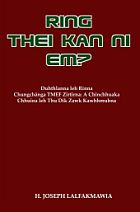Written By KL Pradhan
The Gorkhas who settled down permanently in the state before 1950 and their descendents did not face any problems either from the natives or the government. Before 1980, there was no restriction at all for the them with regard to trade, employment, higher education, allotment of Post-Matric Scholarship, land settlements etc.
It was in early 1980 that the permanent Gorkha settlers began to face the problem of their identity. The main reason behind it seems to be the migration of the Nepalis from and elsewhere, who are engaged as labourers, cowherders, lumberjacks etc.
Since there are no specific differences between the permanent Gorkha settlers and the recent Nepali migrants, It is natural for the native people and the government to treat them as one. The native people refer to this community as Gorkha or Gorkhali rather than Nepali.
The history of Gorkhas settlement in the present state of Mizoram began in the latter part of the nineteenth century. Hey initially migrated from Nepal and later from different parts of the British India. The reasons behind their coming to Mizoram are many.
It is said that the migratory waves from Nepal were caused by the increasing fragmentation of land holding, indebtedness, rising population and declining land availability and unemployment of skilled labours
There is another important aspect, which is universally accepted about their movement particularly in this region and what was the allurement of military adventures
After the Anglo-Gorkha War 1814-16, the British had enrolled the Gorkhas in the British army and posted them to different parts of their dominion. Series of columns, expeditions from 1844 to 1889 were dispatched against the Lushais or what the Mizos were called till 1952. And it was in 1891 that peaceful relation between the British and Lushais was permanently established and the Political Officer was appointed to look after the administration
Once peace prevailed in the hills, the government required man power for developmental works. This was the beginning of the settlement of the Gorkhas in the state. Nirmal Kumar Pun, in his article on the community, has concluded that the Gorkhas began to settle in Mizoram in 1891 while others opine that it was either 1865 or 18715.
The conclusion of Nirmal Kumar Pun regarding the year of Gorkha settlement in Mizoram rings true and I substantiate it. In1896, when the Chin Hills Regulation Act was enforced, the government prohibited the influx of foreigners within the Lushai Hills district except in every special circumstances.
The amalgamation of the North and South Lushai Hills districts as one administrative unit called the Lushai Hills district in 18987 and the early part of the twentieth century farther open opportunities for the Gokhas to migrate and settle here. These Gorkhas who were skilled in various trades were immediately engaged according to the needs of the district administration. Some of them were even employed by the Mizo chiefs in their villages.
The Gokhas, right from the beginning of their settlement, found the geographical location and climate similar to that of Nepal and felt at home. The natives belong to the Mongoloid race as most of the Gorkhas do, and their hospitable, carefree, fun-loving, friendly, straightforward nature helped in developing a close and harmonious relationship between them and the Gorkhas, which later cemented the bond of friendship and brotherhood between the two communities. The Gorkhas, in course of time forgot their place of origin while the Mizos embraced them wholeheartedly. The bon-homie continued till the 1980s.
According to the available records, the first Gorkha families who settled down permanently were found in Maubawk, Khagdiya (Rangvamual) and Kolasib. With the beginning of twentieth century, there was rapid growth in the number of non-Mizo settlers. In case of Gokhas, they were the direct descendents of the discharged military personnel of long services with good conduct, originally recruited in the Lushai Hills.
Apart from above villagers, the Gorkhas settled at Aijal (Aizawl), Sairang, North Vanlaiphai, Lunglei, Dhemagiri around 45 miles of Dwarband Road (now Thingdawl). Gradually, they shifted to other villages, viz, Bairabi, Chhimluang (Aizawl-Silchar Road) North Chaltlang, Kawnpy, Sialsuk, Thenzawl, Tlangnuam, Tuikhaw venghar, Bualpui, Neihbawi, Vairengte, Champhai etc.
They were also found in the southern part of Mizoram, i.e. Saiha and Lawngtlai and Dhemagiri. Those Gorkhas who settled in other villages in smaller numbers are not known. It is presumed that many of them subsequently became Mizos8.
Within Aizawl town areas, the settlements of the Gorkhas are found in Survey Tilla (now Dinthar II), Sriman Tilla (now Zotlang) Khashibanjiang (now Vaivakawn) Patharkhani (Huntar) Zemabawk, Bawngkawn, Durtlang, Sihphir, Bungkawn, Venghuli, Khatla land and Gairgaon (Tuikual).
Before the Independence of India, the Gorkha population in and around Aizawl, the capital of the district was in majority. It is recorded that in Aizawl sub-division, 25 percent of the taxed houses belonged to the Gorkha permanent settlers9.
With the passage of time, the Gorkhas of Mizoram no longer live a life within the ambit of their tradition. Their socio-religious life has undergone a sea change. As this community forms a small minority group in Mizoram and lives in scattered areas, they can hardly be of any threat to the majority tribe. As stated above, they have coped with the living style of the Mizos and have certain obligations towards the same community.
(To be continued…)
Similar Posts:
- Mizoram Gorkhas – II
- Mizoram Gorkhas – III
- Brief history of the Mizo’s in Manipur
- Who are Biate, Baite, Biete
- Gorkha community ecstatic over new Indian Idol





 a tha khawp mai
a tha khawp mai


September 3rd, 2011 at 6:31 am
Gorkha 1 maw… (Y)…. dictionary nen chhiar la tum ila that dawn hi………te ka tia
Report this comment
September 3rd, 2011 at 6:53 am
Chhiar ila…
Report this comment
September 3rd, 2011 at 6:56 am
a va thui ve, la chhunzawm tur nen phei chuan
Report this comment
September 3rd, 2011 at 6:57 am
Mizoram ah Gorkhali/Chakma chumi kuma awm chin te leh an thlahte an awm thei tih, Mizorama pem luhna dan kan neih bik kha a hria em le?
Chakma leh Gorkhali te hriatthiam theih chin kum erawh a inanglo.
Report this comment
September 3rd, 2011 at 8:04 am
A sei em mai ka chhiar chhuak lo mai.. A post tur takin i post a, a tha turah ngai ang. Ka mitthla dan- hmel ena ‘zo’ lo tih chiang ngawih2, mizotawng te lah chu pai eih lo, tawng upa te lah chu a rualpui te aia hre daih zawk, zotawng inti thiam deuh tul mang lova tawng upa hmang deuh sek. thian ho zingah pawh a tawng chak pawl. fiam dawl leh fiamthu duh ve tak.. i nih duh hmel..haha.
Report this comment
September 3rd, 2011 at 8:24 am
Report this comment
September 3rd, 2011 at 8:35 am
KL Pradhan hi kan professor kha a ni ang em aw..?
Report this comment
September 3rd, 2011 at 8:50 am
Hmm… Keini zawng sipai bo kan bang ta map mai……..
Report this comment
September 3rd, 2011 at 9:34 am
A bengvarthlak e. Part II chhiar thuai a chakawm khawp mai.
Report this comment
September 3rd, 2011 at 9:56 am
Report this comment
September 3rd, 2011 at 10:14 am
(@¿@)
Report this comment
September 3rd, 2011 at 10:41 am
Pradhan te cuan OBC nih poh an duh ve don monile.. State thenkhat a poh.. ST category duhlo te an om tho ania.. Gorkha subtribe ami te..
Report this comment
September 3rd, 2011 at 10:41 am
Continue law law se….Korean film en ang mai Nghahhleh awm ve. Postupa ziak ang hian hmanlai Gorkhali ho chu mongoloid race, mizo hmel leh pianphung ang tho annia, mizo awmin an awmta hlawm pawh anih hmel (Mizo kan pung tihna)
Nghahhleh awm ve. Postupa ziak ang hian hmanlai Gorkhali ho chu mongoloid race, mizo hmel leh pianphung ang tho annia, mizo awmin an awmta hlawm pawh anih hmel (Mizo kan pung tihna) 


 .
.
Mahse tunlai Bawngkawn vela Gorkhali ho hi zawng vai sipai ho chhungte ni awm tak tak hlir hmel pu an ni tlats. An hmel atang hian an thiar hran theih mai lo maw Mr. Postupa
Report this comment
September 3rd, 2011 at 10:53 am
Greek tawng emaw Latin tawng emawin a awm lo ami?
Report this comment
September 3rd, 2011 at 11:38 am
A bengvarthlak hle mai.
Mizoram khua leh veng thenkhat hming hi an hming hmasa zawk tihna nge, hnam dang hovin hming dang an lo phuah ve mai zawk le? Dinthar = Patharkhani, he he!
Report this comment
September 3rd, 2011 at 2:36 pm
Gorkhali ho hi Pu Hawla ministry hmasa leh a hma zawng khan inhmun lo ram an LSC thei ngai lo va Pu Hawla kha a phal tlat lo; Pu Zorama a lo lal hnu khan a phalsak a, an ti ta chum chum mai a. Hmun tha tha lah chua an lei zel a. Awm thar tete pawhin an nei zel tawh mai.
Report this comment
September 3rd, 2011 at 10:06 pm
[...] Previous Post @ : Mizoram Gorkhas – I [...]
Report this comment
September 4th, 2011 at 1:14 pm
Gorkhali hi British-ho khan Bengali nen kan inkarah Buffer Zone siam nan an dah hmasa a, mahse tlangmi an lo nih ve avang hian phai a khawsak hi an peih lova tlangramah an lo chhuak leh ta vek an ti.
Tin, 1890 khan Aizawl hi Khaw ram mai a ni a, Sap khan an din thar leh chauh anih kha. Aizawlah hian in sak dawn hian dan fel tak British ho khan an siam a. In chu a dung hlam 7 (about 40Ft) a vang hlam 3 (about 18ft) aiin a lian tur a ni lova. Choka, chawchhum-in a vang hlam 2(about 12ft), a dung hlam 3 (about 18ft) a ni tur a ni, a chung Rangva a khuh vek tur a ni.
Aizawla in sakte hi tumahin an ta ani hlen thei lo. Sawrkar hnathawk te pawhin an ta ani hlen thei bik lo. Tumahin inhmun luah hlen theihna right an nei lo (even Mizos), Hei hian kum 1934 January hma lama in lo nei tawh chu a huam lo. Heng dan awm te hi Mizo Union an rawn lal khan an rawn thiat a, Aizawl hmun tha lai lai chu an in sem ta mai a ni.
Report this comment
September 6th, 2011 at 12:32 am
[...] Post @ : Mizoram Gorkhas – I , Mizoram Gorkhas – [...]
Report this comment